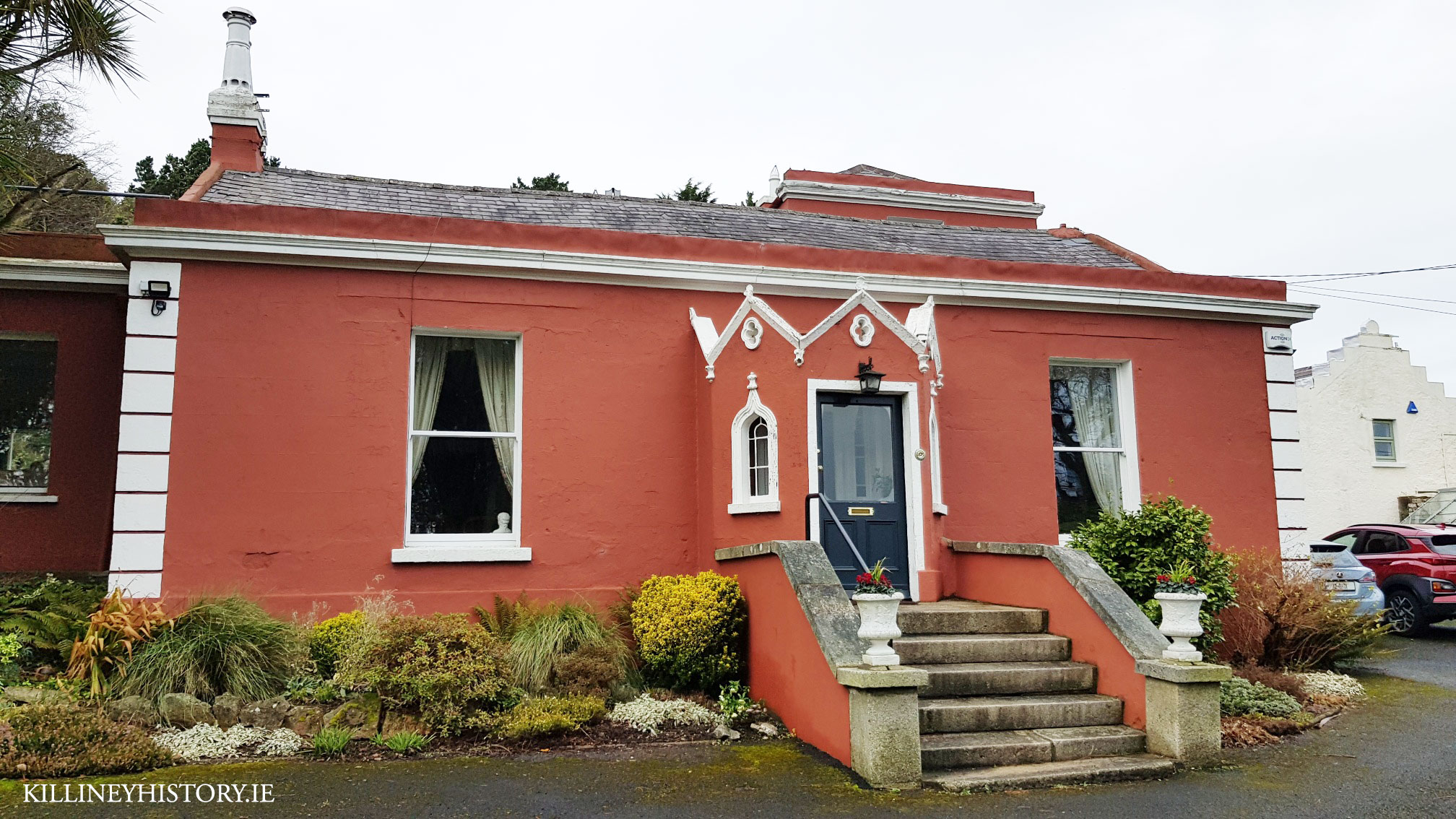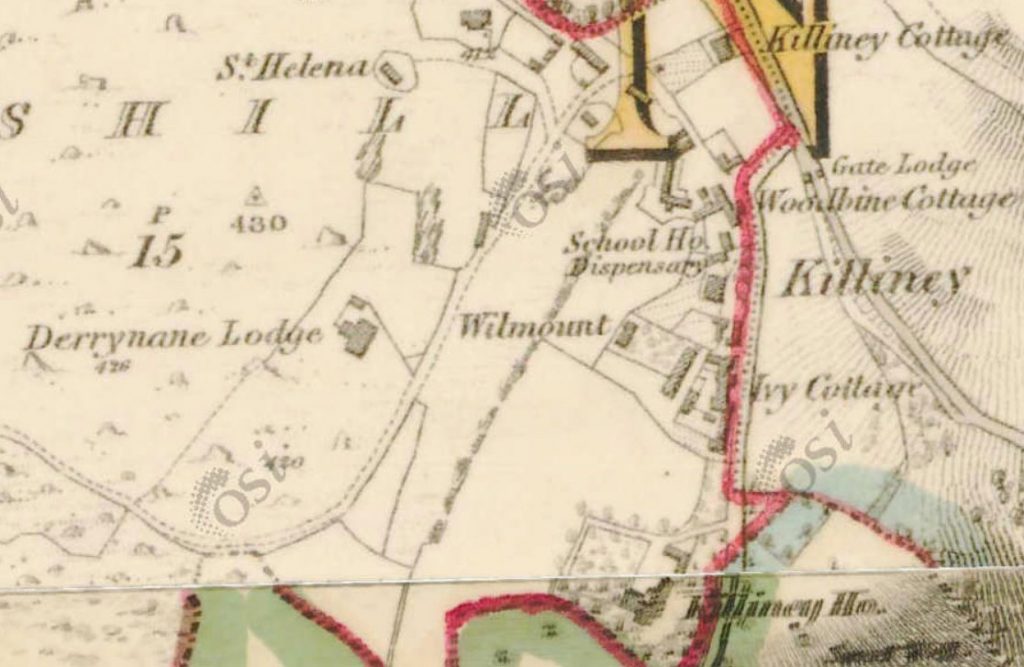
The earliest reference to this property appears on the 1843 Ordnance Survey map where the house is called Derrynane Lodge. The exact date of the erection of the house is unknown (although it does not appear in the 1837 ‘fair plan’ ) but it was one of the first significant residences to be built on Glenalua Road in the early nineteenth century along with the other houses which appear in the Killiney area in the first edition 1843 map.
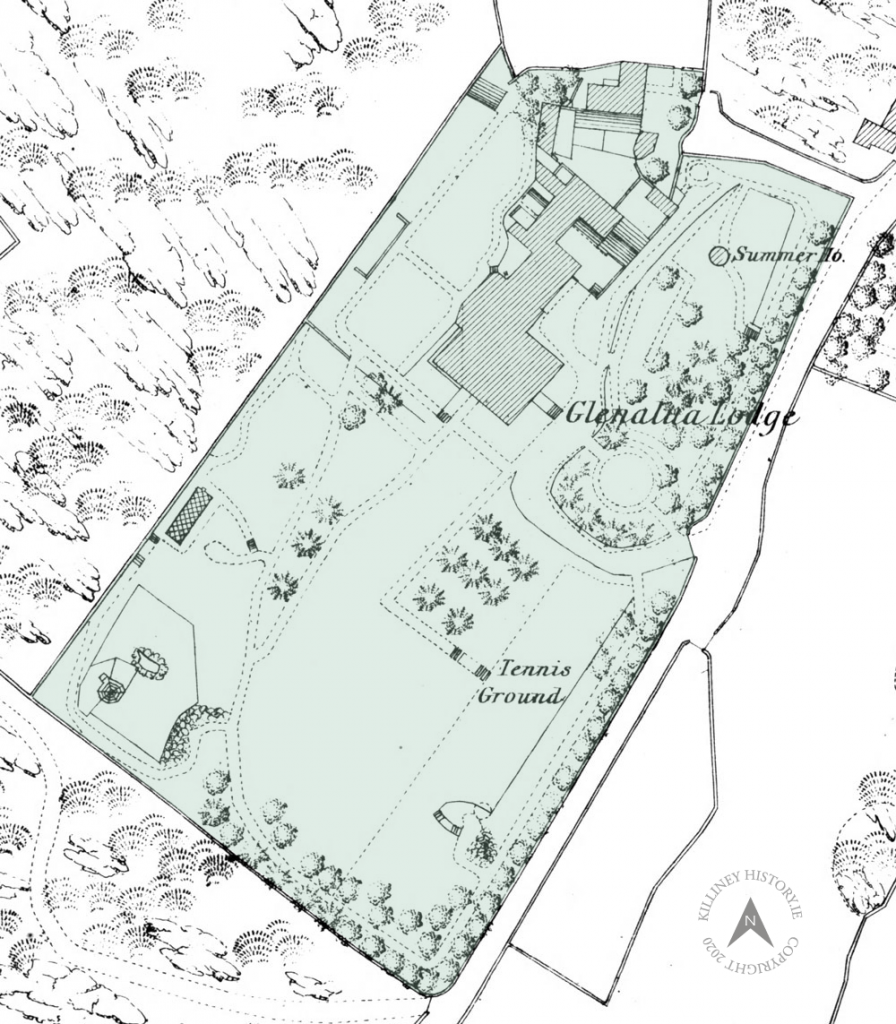
This first wave of development indicates the transition of this area from open countryside to a highly desirable residential area of high amenity value with improving links to the city. The house was built on part of the Talbot estate and has exceptional southerly views of Killiney Bay and Bray Head. It was originally a double fronted single storey building. In the notice of sale by auction by the Court of Bankruptcy in Ireland in April 1891 Glenalua Lodge is described as follows: ‘The dwelling House of Glenalua is most charmingly situate, and commands magnificent views of the Bay of Dublin, Bray and County Dublin Mountains. The grounds are beautifully laid out in terraces, ornamental flower garden, green houses, hot houses, pits, tennis grounds etc., there is also a good kitchen and fruit garden, coachhouse and stabling in an enclosed yard. The house contains 3 reception rooms, 5 bedrooms, kitchen, pantry, servants bedrooms storeroom etc. The entire is in the most complete order and fit for immediate occupation.
Earliest known resident Nicholas Blayney Mathews, father of Washington Mathews.
A Memoriam to the son of N.B. Mathews, Washington Matthews, who was born here in 1843 contains an interesting piece on his birthplace:
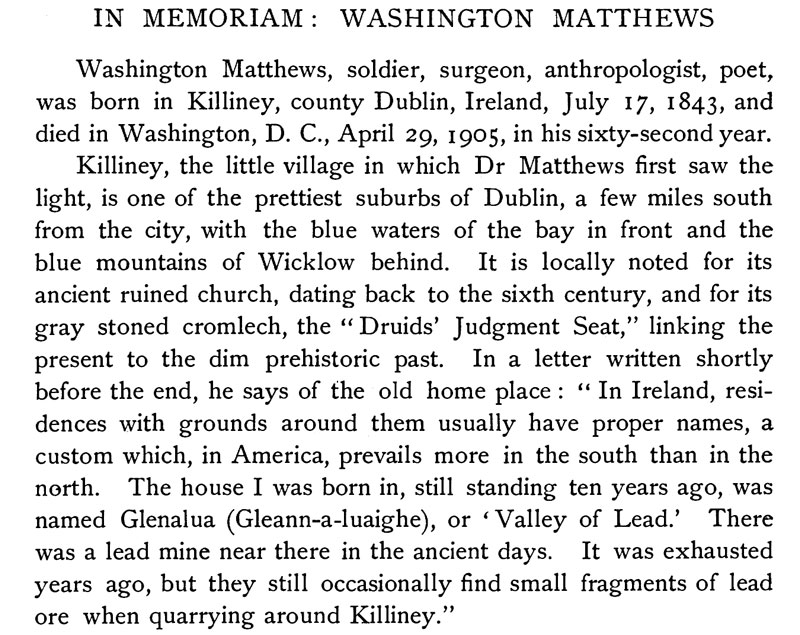

Dr Nicholas Blayney Matthews, father of the subject of our notice, was himself a leading physician and university graduate in medicine. With that admiration for free government which makes every Irishman half an American, he named the boy Washington. While the child was still in infancy, the mother, formerly Miss Anna Burke, died, and the father, finding the old walks lonely without the companion of his love, closed up his affairs at home and came to America in 1847, bringing his two motherless boys with him. After a short residence in Wisconsin, then a territory, he returned with his children to Ireland, where they remained about three years before coming out again to this country, this time to settle in Dubuque, Iowa. Here the boy grew up, having his first education in the common schools, and at seventeen began the study of medicine under his father, with a course of lectures at the medical department of the University of Iowa, from which he received the degree of M.D., May 28, 1864, in his twenty-first year.
Marriage of Nicholas Blayney Mathews to Anna Maria Teresa Burke in 1839

Death of Anna Matthews 1846

Loyal National Repeal Association newspaper report of 1843

Henry Haliday MD and surgeon resident in Derrynane Lodge in 1845
Henry Haliday MD and surgeon is listed as resident of Derrynane Lodge, Killiney in the Pettigrew & Oulton, Dublin Almanac & General Register of Ireland (1845). His medical practice was located at 35 Arran Quay. In later records (Dublin Almanac and General Register of Ireland, 1849) his residence in Killiney is stated simply as Glenalua. In The Gentleman’s and Citizen’s Almanac from this period he is recorded as an Honorary Secretary of the Association for the Suppression of Street Begging in Dublin.
Griffith’s Valuation of 1849 records a Dr. Henry Haliday as occupier who was renting a house with offices (stables) on a plot of just over 2 acres from Patrick Mullen. Patrick Mullen and his family have significant links with Killiney village over an extended period of time. In Griffith’s Valuation they appear as the Immediate Lessors of many properties in Rocheshill and surrounding areas. They held leases on swathes of land in Killiney from the Lord Talbot de Malahide.
The Waterhouse family 1854-1866
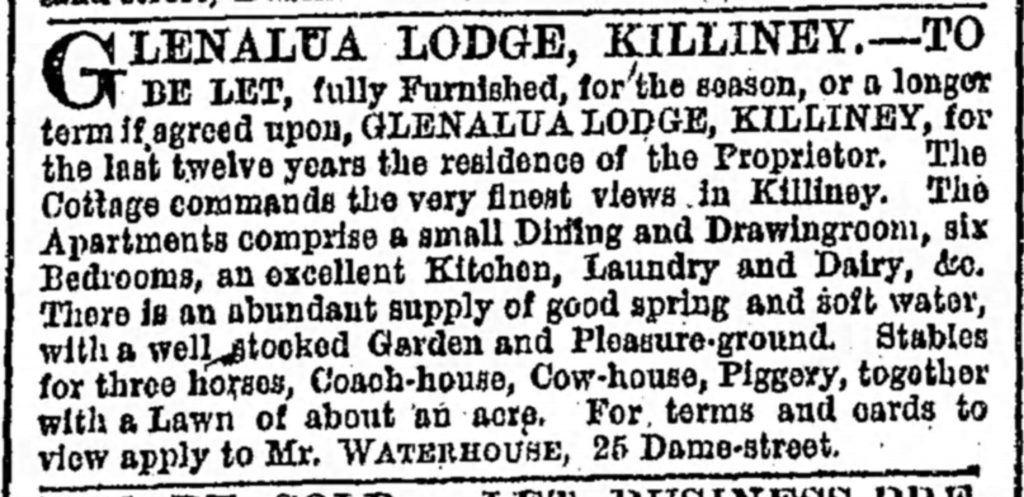
The advert above would suggest that Samuel Waterhouse lived in Glenalua Lodge from 1854 to 1866 when he made the house available to let. This may have been around the time when he and his family moved into Glenalua House, now know as Mount Prospect. His daughter Rosie settled into Glenalua Lodge in 1872 after her marriage to Frank DuBedat.
In 1856 Plans were drawn up to enlarge the original single storey house with a large two storey extension to the front. The plans were drawn up for Samuel Waterhouse by the architect John McCurdy but were never executed. The interesting design would have taken advantage of the fine views from the site. The single storey semi-circular bays to each end of the narrow two storey extension created first floor balconies which would have commanded views in all directions. This was an efficient layout which retained all of the existing single storey accommodation and created a much more imposing property without losing the existing house which was retained behind. These drawings and further plans for extensions to Glenalua Lodge are held by the Irish Architectural Archive ref. T49 McCurdy & Mitchell Collection, 79/17, Bin III, Roll 5.
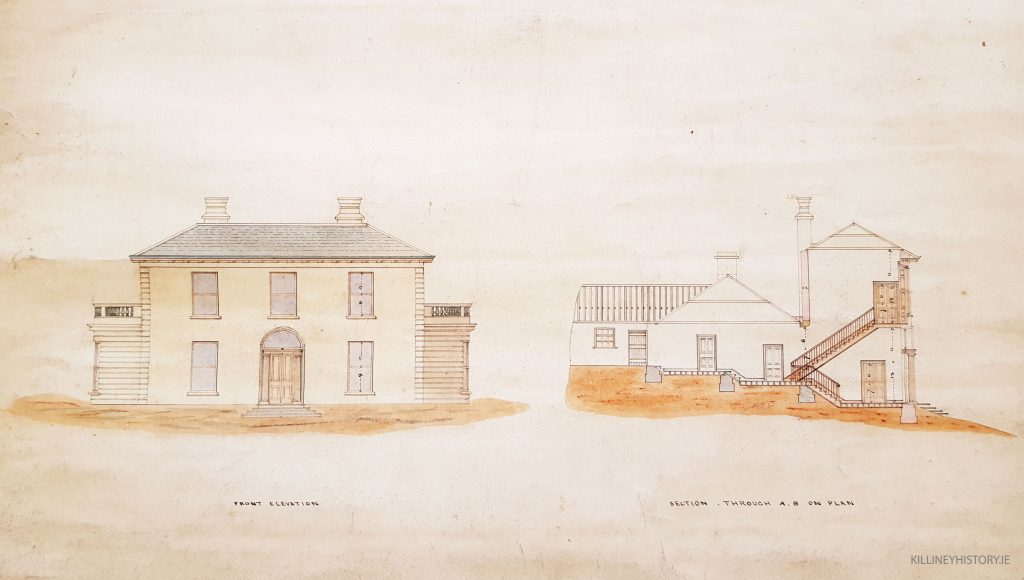
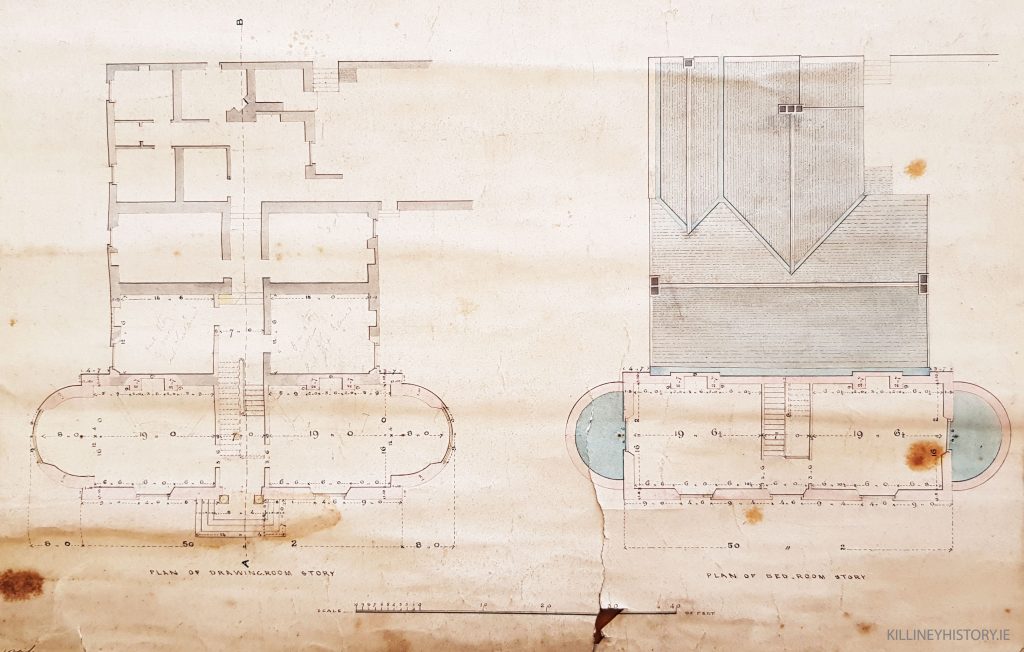
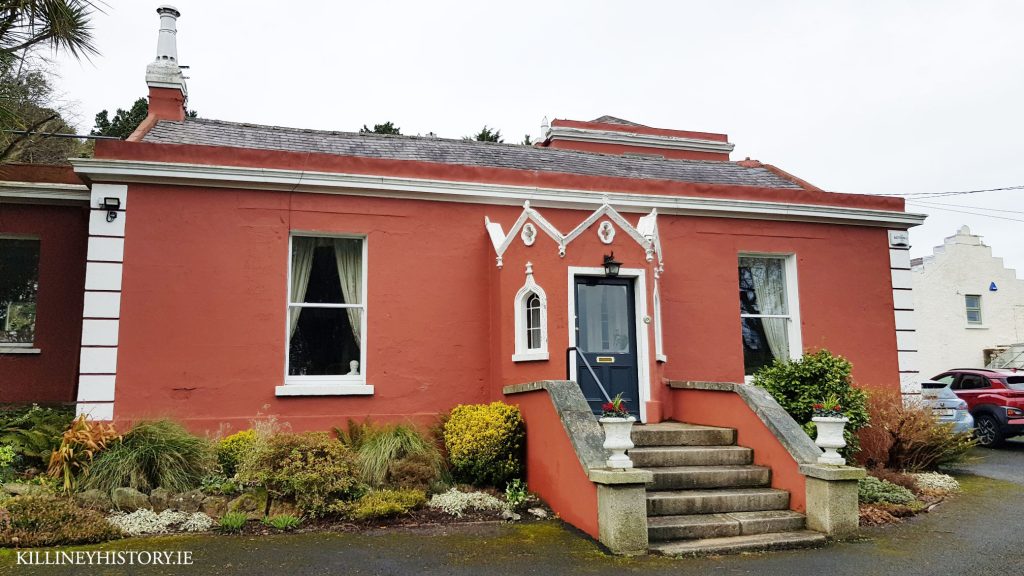
The DuBedat connection 1872-1891
In 1872 Frank DuBedat married Mary Rosa, eldest daughter of Samuel Waterhouse. The Waterhouse family lived in Glenalua House, now called Mount Prospect, at the junction of Glenalua and Killiney Hill Roads. Mary Rosa ( known as Rosie) brought with her a dowry of £3,000 from her father who was a wealthy gold and silversmith who acquired many properties in the vicinity of Killiney village. By 1900 he had all his grown up children but one living around him. The couple settled into Glenalua Lodge in 1872 and they lived their with their three children for almost twenty years. The internal ornate plasterwork is attributed to their time living in the house. Frank was a high flying stockbroker who came from a French Huguenot family who ran a highly regarded stockbroking firm with an impeccable financial reputation.
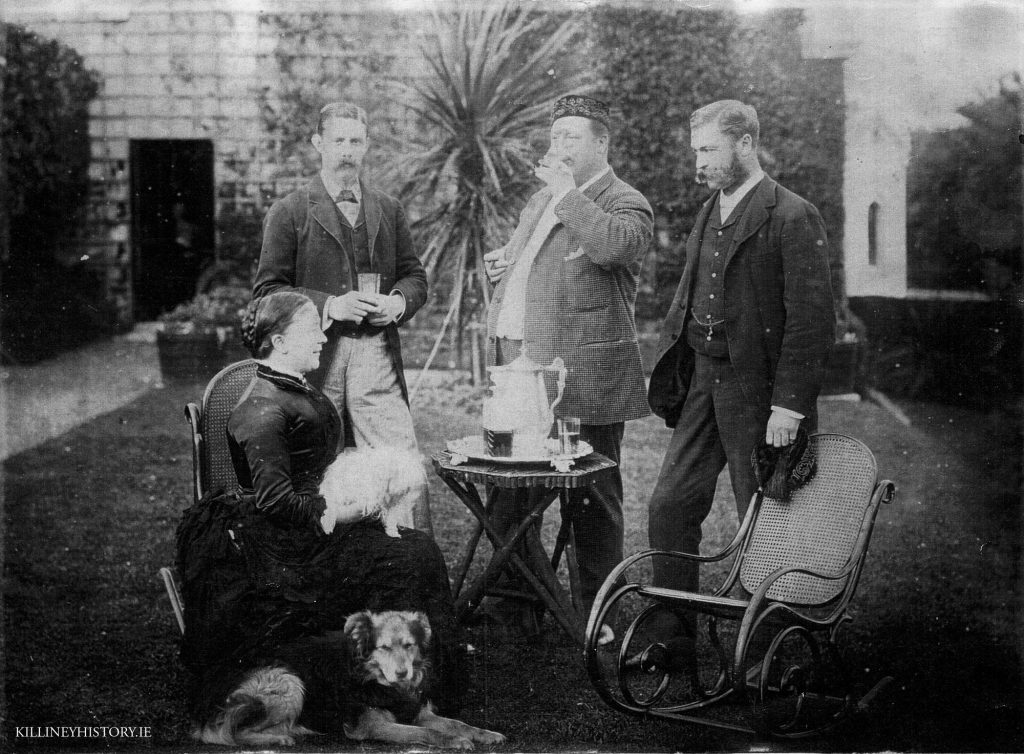
In 1889 Frank and Rosie acquired Stoneleigh at the top of St. George’s Avenue. Frank had grandiose plans for the property and spent in the region of £7,000 building new stables and renovating the existing house. The house was renamed Frankfort. Frank borrowed heavily to finance the work and pay for his lavish lifestyle. This was to lead to his ultimate downfall which is detailed in another article on this website.
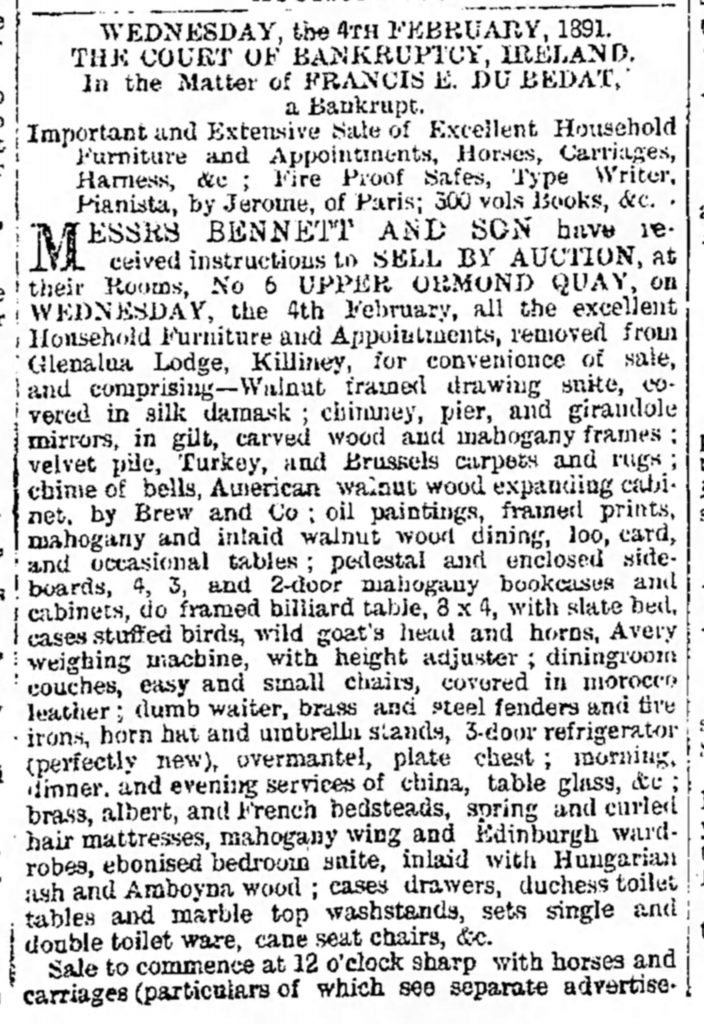
The sale notice of the contents of Glenalua Lodge give an indication of the wealth and lifestyle of the recently bankrupted Frank DuBedat.
Repurchase of the property by S.S. Waterhouse in 1891
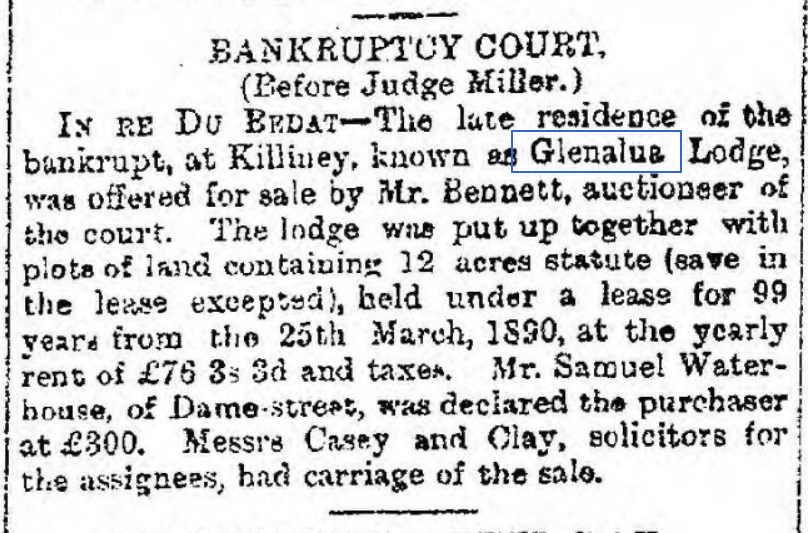
Neil & Elizabeth McInnes residence from 1904-1910
The present owners of Glenalua Lodge, Paul and Ruth Stewart, kindly provided the photographs and information below which they received from Susan and David McInnes of Vancouver, Canada. David’s grandparents lived in Glenalua Lodge from c.1905 to 1910.
The following is an extract from the family history of the McInnes family written by N. Dermott McInnes who was born in Glenalua Lodge in 1908:
When I arrived in Killiney from Dublin on my very first visit to Britain in 1976, I was ecstatic with excitement. Upon getting off the bus the first sign I noticed was “Killiney Store”. Almost immediately I saw a street sign in Gaelic and English, covered with graffiti, indicating this was Glenalua Road. I followed this road until I came to the name “Glenalua Lodge”.
For some years I had enjoyed the picture my parents brought to Canada, and now among my treasured possessions, of a stately home set amidst immaculately kept terraced lawns and flower gardens and graced with walks, a driveway, and a variety of trees including palms. I had not really known what house this was and now, suddenly, I knew. This was Glenalua Lodge before my eyes, the place of my birth. The house seemed much the same as in the picture, and the general design of the grounds did not appear to have changed yet the whole scene looked a little tired. This had been the year of the great drought in Britain, and the lawns were brown and looked discouraged. This was September and the summer flowers were fading, but Glenalua Lodge was putting up a brave front.
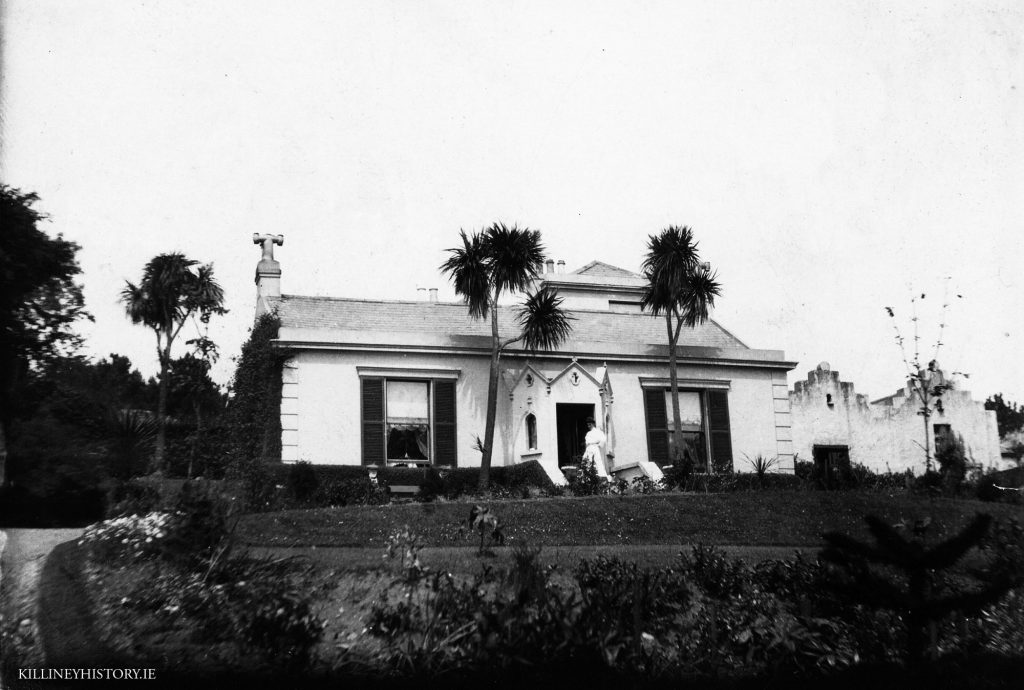
I had previously been in touch with Mr. and Mrs. Brett, the occupants at the time, but they were not at home and I did not see inside the main part of the house. I met the young couple from New Zealand who were there for two years while he studied, living in the separate section of the home which was once the carriage house. The wife, who enjoys pottery gave me a little dish she had made, and served me tea and “people’s bread” (bread subsidized by the Irish government) and cheese. I also spent a few pleasant moments with Mr. Nuttall Smith, the former owner, and his daughter who was visiting him. Mr. Smith lives in what used to be the greenhouse and it was a delight being in the comfortable glass home with its climbing greenery.
This is the place to mention a most informative letter which I received in 1966 from Katie Johnson who lived in Chicago. My mother had spoken of Katie and Bridie in my boyhood but I did not really understand her connection with them. During my mother’s stay in a nursing home in 1966 prior to her death, I found names of persons in her address book to whom I felt I should write. One of these was Katie Johnson (this would be her married name). In reply to my letter Katie wrote:
Your mother and father came to Kingstown on their honeymoon. Your father rented a beautiful house for three months. One of my older sisters was taking care of children in this house. Your mother asked my sister to stay on with your mother and father and do cooking and housework. My sister stayed and worked for your mother and father for several years. Later your father rented a very large house in Killiney. You were born in that beautiful home. Your mother asked me if I would come and work with my sister. I was so happy. I liked your mother very much. I was with her when you were born.
Thus from Katie Johnson I learned a great deal about the Killiney and nearby Kingstown (Dun Laoghaire since Eire became independent) years. I think the older sister was Bridie, and I assume Neil and Elizabeth moved to Glenalua Lodge after the three months in Kingstown. It would appear that Killiney remained their home until they left for Canada in 1910. Mae and I had an opportunity to visit the inside of the home in 1982 and were impressed by its beauty, its comfort, its setting near Killiney Bay, and in view of the Wicklow Hills. Jasper Brett was not at home but his wife Jan graciously showed us the house which they dearly love.
So Neil and Elizabeth settled into their Irish home, and employed domestic servants who became their friends. My mother kept up a correspondence with Katie for more than half a century after she left for Canada. They had a car which must have been one of the first in the country. My picture of Glenalua Lodge showing Neil sitting behind the wheel high on the front seat of this vintage model. Elizabeth is sitting near the driveway with a small dog in her lap. The registration number for the motor car, A8243 seen clearly on the licence plate, was issued according to the Motor Car Acts 1896 and 1903 by the London County Council on December 29, 1904. Was the car a Christmas present to themselves? My mother’s driver’s licence No. 615 was renewed, in accordance with the same Acts, for one year on May 1, 1907. I was born the following January. Was she driving during her pregnancy? Did she ever drive her young son in the car?

“Mrs. Neil J. McInnes” soon had an attractive personal card printed and their Christmas card, 1905, “Kindly greetings and the good old wish, A Merry Christmas and a Happy New Year, from Mr. and Mrs. Neil J. McInnes” included the words, “As years fleet by may mutual friendship grow more close and sweet”
Speaking of friendship, I wonder about their social life. One picture I have suggests they enjoyed the genteel sport of croquet. With mallets in hand they posed with a group of well dressed men and women. I hardly recognized my father at first. Without a moustache he appeared much younger. Elizabeth, stylishly dressed, seemed extremely well and happy.
Neil sat for Chas. Cook, Art Photographer, Kingstown, who produced a superb portrait. Lafayette, address unclear, did the same for Elizabeth. When I was born Chas. Cook took an excellent picture of the nurse proudly holding the new arrival while his mother looked happily on. Where was Katie who said she was present at my birth? Among my mother’s keepsakes was a postcard from Chas. Cook to her at “Newport, Pagnell, Bucks” dated May 19, 1911, reading “Dear Madam. Enclosed find proof of Baby and Nurse. As negative was not developed the same time as the others the proof was overlooked. If you would like any finished copies of same kindly let us know”. By that time my parents had been in Canada for a year but the postcard reached them!
Estate Deeds
The title deeds of one of the houses built on the estate in the last century contain a reference to the original estate from which the plot was sub-divided as follows:
WHEREAS by Indenture of Lease dated the Twenty-fourth day of July One thousand eight hundred and ninety (1890) and made between Edward Lister Kay Talbot of Ballinclea Dalkey in the County of Dublin of the one part and Francis Edward Du Bedat of Glenalua Lodge Killiney in the said County of Dublin of the other part the hereditaments therein described as “ALL THAT AND THOSE the dwelling house and premises known as Glenalua Lodge, Lamberts Cottage and Dog Kennells together with the plots of land as more particularly delineated and set forth in the map endorsed on these presents and hereinafter referred to and containing in the whole twelve acres and eighteen perches statute measure be the same more or less all of which said demised houses and plots of land are situate at Killiney in the parish of Monkstown Barony of Rathdown and County of Dublin.
Although Frank DuBedat was progressing with his renovation and extension at Stoneleigh, George’s Avenue, at this time he was also entering into a new lease for Glenalua Lodge and the surrounding 12 acres as shaded red on the map below. The estate was in the ownership of Edward Lister Kay Talbot of Ballinclea who was a member of the Talbot family of Malahide. No further information has come to light in relation to Lamberts Cottage and Dog Kennells but a further clause in the lease dating from 1935 goes on to mention Kennel Lodge let to Patrick Murdock Senior, Kennel Field let to Patrick J. Dowd and a Field known as Big Hill let to William Hall. Recently obtained local knowledge confirms that Kennel Lodge which was occupied by Patrick Murdock was known as Murdock’s cottage and was located where No.1 Glenalua Heights now stands. The houses of Glenalua Heights now occupy what was known as Kennel Field (Plot identified as .684 on the map below). We understand from a local source that it was Greyhounds which were kept in this field. This is confirmed in the death notice of Samuel Waterhouse who died in 1905, ‘Passionately devoted to coursing he was for over 40 years a prominent follower of the Leash, and up to the last kept a kennel of greyhounds, some of which he ran during the season 1904-5.’ He attributed his long life and robust health in no small degree to his love of, and active participation in, the sport of coursing.
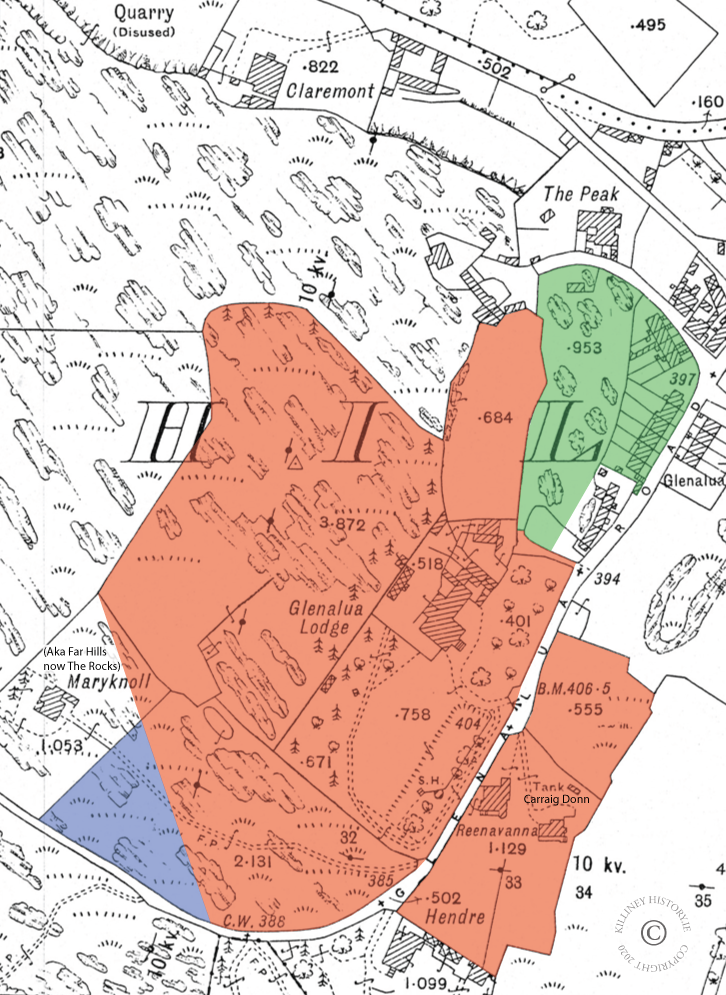
Parties to the 1936 lease were: Annie Alma Waterhouse, John H. Waterhouse and Samuel H. Waterhouse of the first part Samuel H. Waterhouse, Kathleen Ann Haffield, John H. Waterhouse, William F. Waterhouse, Lilian Maud Robinson, Harriette Ann Waterhouse, Halifax Waterhouse, George Waterhouse and Mary V. Brewer of the second part AND Bernard Joseph Fagan of the third part.
Bernard Joseph Fagan went on to build Reenavanna and Carraig Donn in 1936.
Another interesting aspect to this document is the reference to the plot of land shaded green on the map which is the site upon which Glenalua Terrace was built:
were acquired by and became vested for an estate in Fee Simple in possession in the Urban District Council of the Urban District of Killiney and Ballybrack in pursuance of an Order entitled “The Killiney and Ballybrack Urban District Order, 1910” and in pursuance of the housing of the Working Classes (Ireland) Acts 1890 to 1908.
See article on Glenalua Terrace for further information.
Present day houses built within the immediate grounds of Glenalua Lodge

- Glenalua Lodge
- The Glasshouse
- The Greenhouse
- The Coach House
- The Stables
- Hialeah which was built on the site of the original tennis court
- Blue Ridge, previously Finchory
(Further information to follow on the above houses.)
Records from Thom’s Directory and others
| 1843 | Mathews, Nicholas Blayney (Darrynane Lodge) |
| 1845 | Haliday, Dr. Henry (house is called Derrynane Lodge) |
| 1849&1850 | Haliday, Dr. Henry (house is called Glenalua) |
| 1852 | Nicholas Blayney Mathews (incorrectly listed as ‘Glenabra’) |
| 1854-1866 | Waterhouse, Samuel |
| 1872-1887 | DuBedat, Francis Edward and Mary Rosa Waterhouse |
| 1887-1889 | DuBedat, Fras. E. Esq |
| 1892 | Walker-Lee, Mrs. |
| 1896-1900 | Turbett, Robert James |
| 1905 | Vacant |
| 1906-1910 | McInnes, Neil J. Esq |
| 1911-1913 | Kenny, Michael E. Comyn, B.A. M.E. |
| 1917-1921 | LeFanu, H.B., R.N., divisional officer of coastguards, Kingstown |
| 1923-26 | Glennon, W.R. |
| 1928-1930 | Alton, Percy Geo., |
| 1934-1940 | McCarthy, Miss E. |
| 1943 | Harte, L. P. |
| 1945-1947 | O’Driscoll, T.J. (Jim?) |
| 1950 | David, H.G. |
| 1952 | Vacant |
| 1955-1961 | Nuthall Smith, H |
| 1977-1989 | Brett, Jasper |
| 1989-2023 | Paul & Ruth Stewart |
| 2023- | Paul Stewart |
Geological Survey in the vicinity of Glenalua Road, 1900.
Extract from: On the Epidiorite and Mica Schists of Killiney Park, Co. Dublin by J. P. O’Reilly. Proceedings of the Royal Irish Academy (1889-1901), Vol. 6 (1900 – 1902), pp. 19-25
In the present paper I propose to examine the beds occurring in the locality referred to on p. 34 of the Memoir, and described as lying between Killiney Lodge and Killiney Park. Owing to the development of residential properties in this locality, and the consequent alterations in the old boundary lines since the date of the Memoir in question, it is necessary, in order that the lie of the ground in the locality may be better understood, to give the names of the present residences and grounds, as marked on the more recent Ordnance maps, which are laid down on a scale of five feet to the mile, and numbered xxiii. 97 and xxvi. 17.
Examining these, it will be observed that the road which branches off to the W.S.W. from Killiney village at Glenalua Lodge turns to the S.W. at Venetian Cottage, and continues to Glenalua Lodge, where it inflects to the W.N.W. at the entrance to Hendri. Quite near this it crosses the well-marked fault existing between the granite and the mica schist in this locality.
Near the gateway of Glenalua Lodge, when coming from Killiney village, the observer meets on the north side, or right hand, a rough piece of ground, showing outcrops of the mica schists so characteristic of the locality, and at one or two points, immediately under the boundary wall of Glenalua Lodge, outcrops of a rock which will be further considered. Apparently this was the quarry of slate rock referred to in the Geological Survey Memoir already cited, and from which the stones found in its boundary walls, and more particularly in the coping of the boundary wall of the quarry next the road, were taken ; the outcrops of the rock in question, being extremely hard, and not easily worked, were left outstanding, and therefore quite accessible for examination. The fault already referred to traverses this old quarry field, and passes into the adjacent grounds of the Lodge.
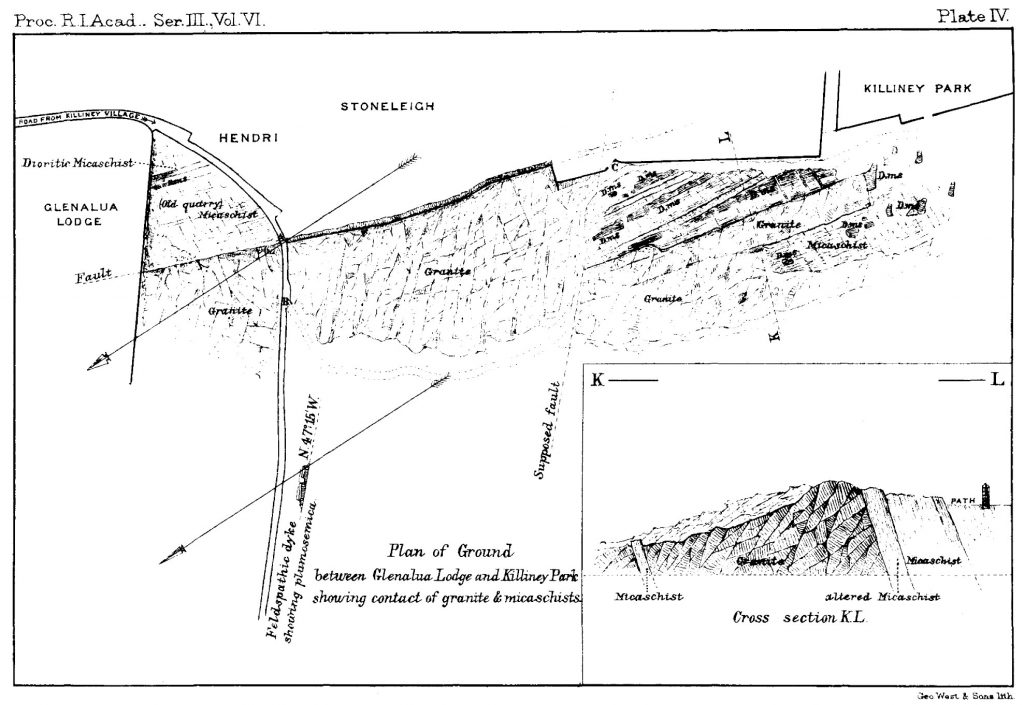
At the point marked B on the accompanying enlarged plan of the ground, is a wicket-gate, giving ingress on to the hill, to the west of Stoneleigh ; here a barely traceable path skirts the margin of the granite on its south side, and leads to the back-entrance of that property. From this entrance (marked C on the accompanying plan) there extends along the boundary wall, to the gate leading into Killiney Park, a patch of ground showing markedly the mica schist outcrops, tongued by the granite as described in the Memoir, and in certain bands thereof, marked on the plan with the letter D, a crystalline rock of the same nature as that which outcrops in the old quarry at Glenalua Lodge already referred to, bearing every evidence of its metamorphism
